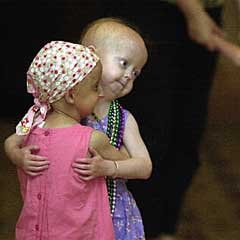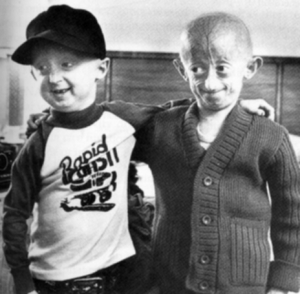|

Progeria, or Hutchinson-Gilford progeria syndrome, is a rare fatal, genetic condition of childhood with striking features
resembling premature aging. Children with progeria usually have a normal appearance in early infancy. At approximately nine
to 24 months of age, affected children begin to experience profound growth delays, resulting in short stature and low weight.
They also develop a distinctive facial appearance characterized by a disproportionately small face in comparison to the head;
an underdeveloped jaw (micrognathia); malformation and crowding of the teeth; abnormally prominent eyes; a small, nose; prominent
eyes and a subtle blueness around the mouth. In addition, by the second year of life, the scalp hair, eyebrows, and eyelashes
are lost (alopecia), and the scalp hair may be replaced by small, downy, white or blond hairs. Additional characteristic features
include generalized atherosclerosis, cardiovascular disease and stroke, hip dislocations, unusually prominent veins of the
scalp, loss of the layer of fat beneath the skin (subcutaneous adipose tissue), defects of the nails, joint stiffness, skeletal
defects, and/or other abnormalities. According to reports in the medical literature, individuals with Hutchinson-Gilford progeria
syndrome develop premature, widespread thickening and loss of elasticity of artery walls (arteriosclerosis), which result
in life-threatening complications during childhood, adolescence, or early adulthood. Children with progeria die of heart disease
(atherosclerosis) at an average age of 13 years, with a range of about eight to 21 years.
Progeria is caused by a mutation of the gene LMNA, or lamin A. The lamin A protein is the scaffolding that holds the nucleus
of a cell together. Researchers now believe that the defective lamin A protein makes the nucleus unstable. That cellular instability
appears to lead to the process of premature aging in progeria. Because neither parent carries or expresses the mutation, each
case is believed to represent a sporadic, new mutation that happens most notably in a single sperm or egg immediately prior
to conception.
Credit to - www.rarediseases.org

|
|
Please donate to a Progeria charity today and help these poor children!
Progeria Research Foundation
P.O. Box 3453
Peabody, MA 01961-3453
Phone: 978-535-2594
E-mail: info@progeriaresearch.org
Home page: http://www.progeriaresearch.org
or send to
Progeria Research Foundation, Inc.
532 Lowell Street
Peabody, MA 01961-3453
|



